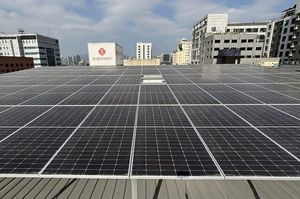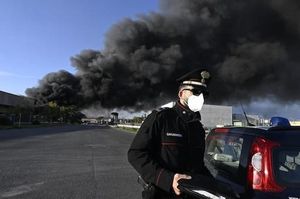On April 4, 2025, a significant moment in South Korean politics unfolded as the Constitutional Court delivered its verdict on the impeachment trial of President Yoon Seok-yeol. Chief Judge Moon Hyung-bae announced the decision at the Grand Courtroom in Jongno-gu, Seoul, at 11 AM, after a day filled with anticipation and tension.
Judges arrived early, with many reaching the court before 8:30 AM to finalize their deliberations. Chief Judge Moon was the last to arrive, entering the court without comment or baggage, as the other judges followed suit in a similar manner, each maintaining a solemn demeanor. Judge Jeong Hyeong-sik, who arrived at 6:55 AM, was escorted by security as he swiftly entered the building. The atmosphere was charged as the judges prepared for the final review, which commenced at 9:30 AM.
Outside the court, a large gathering of citizens supporting the impeachment of President Yoon had been forming since the previous night. They congregated in a designated area near the Constitutional Court, known as a 'controlled zone,' where access was restricted to ensure the safety of the proceedings. Many participants had spent the night in vigil, holding signs and chanting slogans demanding the president's removal.
Progressive civic groups, including the Candlelight Action and the Korean Confederation of Trade Unions (KCTU), organized the rallies that began at 7 PM on April 3, 2025. They set up near Anguk Station, just a short distance from the court, where they planned to monitor the verdict live. As the crowd grew, they expressed their hopes for a unanimous decision from the judges to impeach the president.
"We are here to protect democracy and demand that the Constitutional Court judges deliver a unanimous verdict of 8-0 in favor of impeachment," a representative from the Candlelight Action stated. The group planned to celebrate if the impeachment was approved, while also preparing for protests outside the presidential office should the verdict go against them.
Security measures were heightened in response to the anticipated large crowds. Approximately 7,510 police officers, along with 110 mobile units, were deployed around the Constitutional Court and nearby areas to maintain order. Traffic was heavily restricted on major roads, including Yulgok-ro and Bukchon-ro, with some subway stations, like Anguk Station, closing all entrances and exits to manage the influx of people.
As the hour drew closer to the verdict, tensions mounted. Supporters of the impeachment were visibly anxious, while opponents of the move were also present, albeit in smaller numbers. The atmosphere was electric, with chants echoing through the streets as the main rally was set to begin at 10 AM.
By the time the judges entered the Grand Courtroom, the anticipation was palpable. The public and media were eager to hear the outcome of a trial that had captivated the nation for months. The judges took their seats, and the moment of truth arrived as Chief Judge Moon began reading the decision.
The significance of this trial cannot be overstated. It represents a critical juncture in South Korea's democratic process, reflecting the ongoing struggles between political factions and the public's desire for accountability. President Yoon's administration has faced numerous controversies, leading to widespread calls for his impeachment. The court's ruling would not only determine Yoon's political fate but also set a precedent for future administrations.
As the court proceedings were underway, the rally outside continued to grow, with more citizens joining in solidarity. The KCTU had warned that if the impeachment were to be rejected, they would initiate a general strike, indicating the seriousness of the situation.
The atmosphere was a mix of hope and anxiety, as supporters of the impeachment held their breath, waiting for the judges to announce their decision. Many had come prepared for a long day, equipped with food, water, and banners proclaiming their support for a democratic process free of corruption.
Meanwhile, the police maintained a visible presence, ensuring that the situation remained under control. They had set up barricades to manage the flow of people and prevent any potential unrest. The area around the court was transformed into a scene of political expression, with passionate chants and speeches resonating through the crowd.
In the lead-up to the verdict, the discussions among the judges were intense. The final review was crucial, as it would determine the language of the decision and the implications for the future of Yoon's presidency. The judges' deliberations were conducted with the utmost seriousness, reflecting the weight of their responsibility.
As the clock struck 11 AM, the moment everyone had been waiting for arrived. Chief Judge Moon began to read the verdict, and the atmosphere shifted from anxious anticipation to focused attention. Citizens outside the court gathered around screens to watch the live broadcast, their hopes pinned on the judges' words.
This impeachment trial has been a defining moment in South Korea's political landscape, illustrating the deep divisions within society and the ongoing struggle for accountability in governance. As the verdict was read, it became clear that the outcome would resonate far beyond the walls of the Constitutional Court, shaping the future of South Korean politics.
In the end, the decision made by the Constitutional Court would not only affect President Yoon's political future but also serve as a litmus test for the health of democracy in South Korea. As the day unfolded, the nation held its breath, eager to see what the judges would decide.
![[포토] 윤석열 대통령 탄핵심판 선고](https://thumbor.evrimagaci.org/imibVLpcnHMo4xI5ctyZxg18qtw=/200x0/tpg%2Fsources%2F9ce9ced6-aaf1-48e1-b4d4-19d15619cd8d.jpeg)
![[속보]‘윤석열 탄핵 심판’ 헌법재판관들 전원 출근…오전 9시30분 마지막 평의](https://thumbor.evrimagaci.org/hKnFdiqjTWEwUgZAm9tRyzXRN68=/200x0/tpg%2Fsources%2Faff889de-9ad2-4373-b65b-31187ce32a78.jpeg)




